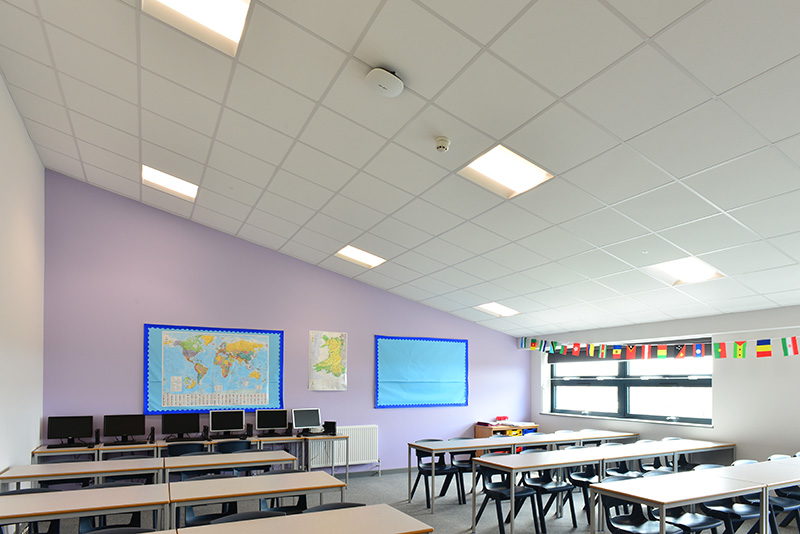
Michael Anderson, head of A&D – UK & Ireland – at ceiling solutions specialist Zentia, tells Project Scotland about the vital role of acoustics in the school learning experience
CLASSROOMS have always provided the backdrop for the cultivation of knowledge and personal growth, allowing teachers to impart new skills, and students to absorb new insights. Yet, when it comes to classroom design, the role of acoustics can often be overlooked in terms of importance.
The auditory quality within a classroom can hold substantial influence over the learning experience for both students and teachers. Insufficient acoustics can create an unhealthy learning environment, creating adverse effects on students’ attitudes, behaviour, and retention rates.
It can even effect student and teachers’ health and well-being, both long-term and short-term. Recognising the significance of this issue, the UK Government published guidance in the form of Building Bulletin 93 (BB93) setting out guidance for the acoustic blueprint of classrooms. Whilst Scotland does not hold a statutory standard, it often refers to BB93 and incorporates it into performance standards.
The sound of education
In a classroom where the teacher’s voice is contending with external disturbances such as footsteps, conversations, and distant chatter, maintaining student focus on lessons becomes increasingly difficult.
Numerous studies have been conducted to prove the negative impact poor acoustics can have in the classroom. When students experience auditory distractions that overshadow the teacher’s voice, their ability to concentrate diminishes, leading to less active participation, enthusiasm, and an overall negative outlook toward learning.
Unfortunately, failing to hear and therefore retain information within the classroom can result in academic underperformance and a failure to grasp fundamental concepts.
The impacts extend beyond engagement. Research reveals that students in noisy classrooms exhibit a higher tendency for disruptive behaviour. The frustration stemming from not being able to hear clearly can cause restlessness, misconduct, and disciplinary issues.
Teachers also pay a price in poor classroom acoustics. As noise levels surge, teachers may experience heightened stress levels.
The constant exertion required to make themselves heard can lead to vocal strain, fatigue, and increased frustration. These stressors can lead to physiological responses such as elevated heart rates, which, if chronic, may cause more severe, long-term health conditions such as hypertension and heart disease.
Government guidance
The UK Government has recognised the importance of the issue, and published directives through Building Bulletin 93 (BB93). The document defines acoustic standards and recommendations for the design of both new and renovated educational facilities.
BB93 published precise criteria for various spaces within educational institutions, including classrooms, assembly halls, and music rooms. It mandates maximum ambient noise thresholds and acoustic performance benchmarks that must be met to create an environment conducive to learning.
The guidance also underscores the importance of sound insulation between spaces to prevent unwanted noise movement, ensuring that classrooms remain tranquil enough to facilitate learning.
Creating environments for learning
Zentia provide expert solutions and acoustic products that can help create optimal learning settings. Creating an acoustically-sound learning environment requires a multifaceted undertaking that necessitates a holistic approach.
Committed to enhancing the auditory quality of classrooms, Zentia offers practical solutions that align with the standards set out in BB93.
A crucial constituent of classroom acoustics is acoustic ceiling systems, playing a decisive role in sound control within a space. Acoustic ceiling tiles are designed with sound-absorbing materials, reducing echo and reverberation within a room.
Ceiling tiles equipped with sound-attenuating properties further remove noise transmission between spaces, putting a halt to unwanted sounds.
Zentia’s product range provides a diverse array of acoustic ceiling solutions tailored to unique learning environment requirements. Zentia’s latest product addition, Sonify, is engineered to absorb and attenuate sound, diminishing ambient noise levels and enhancing speech intelligibility. Offering a variety of designs and finishes, Zentia’s acoustic ceiling systems not only serve functional purposes but also help with zoning, wayfinding and increasing the aesthetic appeal of classrooms.
In the journey that students undertake throughout their educational milestones, the significance of acoustic design often remains an unsung hero. Yet, the auditory quality within a classroom can either bolster or undermine the learning experience. It shapes students’ engagement, behaviour, and retention, while also impacting the well-being of educators.
In the pursuit of expert solutions, Zentia provides creative, innovative, and dependable solutions for educational institutions. Through an assortment of acoustic ceiling systems and bespoke offerings, Zentia empowers educational establishments to create acoustic environments that actively promote engagement, encourage learning, and prioritise the well-being of students and teachers.








